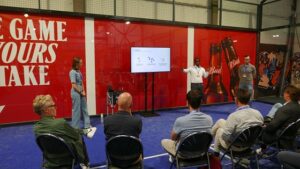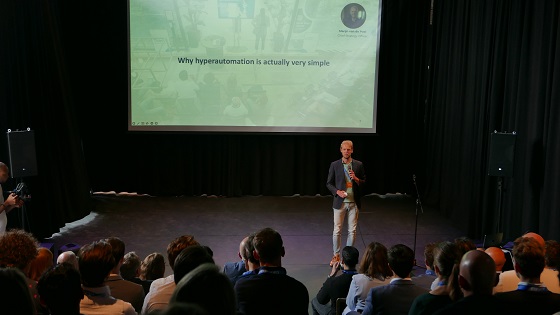For several years now, ‘taking the robot out of the human’ has been the motto of Ciphix. However, the way this can be done has evolved significantly, especially with generative AI taking center stage. At an event in Delft Ciphix discussed the way an automation journey can add value for an organization.
“With so much technological advancements, there is no need for tedious and boring jobs anymore,” Marijn van de Poel, Chief Strategy Officer at Ciphix, kicked off an event dedicated to the benefits of AI and hyperautomation. “If you see people typing in Excel and moving data from left to right, then automation might be a solution.” This also addresses the infamous shortage of skilled labor, which encompasses two primary facets: the recruitment of suitable individuals and the retention of talented professionals.
To contextualize the evolution of automation, he took the audience on a brief journey through time. Before hyperautomation, the realm of automation itself had already made significant strides. The proliferation of large-scale systems like SAP and Salesforce promised streamlined processes through straight-through processing.
Hyperautomation
However, despite their commendable achievements, some departments continued to experience bottlenecks and extensive product backlogs, indicating that the ultimate solution had not yet been found. “Automation really jumps into that gap in the market, augmenting ERP systems and making processes more efficient.”
By leveraging the power of automation, businesses can achieve substantial gains, automating ’the last mile’- up to 90% or even 100%- of their processes. The cycle of automation is starts with identifying suitable use cases, demonstrating the technology’s capabilities to stakeholders, building automations, and ultimately making people happy with the results. As the team grows, so does the importance of governance and capturing the value of the automations being built.
In the next step, hyperautomation, organizations deploy multiple powerful technologies and efficient governance. “Hyper automation involves high-end technology solutions and low-code platforms for impactful automation. Inspiring business units, process optimization, building solutions, and change management are the steps to go through in automation.”
The Transformative Power of AI
Next on stage, Job van den Berg, co-founder of AI.nl, highlighted the transformative power of AI and the profound impact it can have on various aspects of our lives. “AI is the means to find solutions to issues in society. It is more profound than electricity and will have a significant impact,” he stated. From healthcare to climate change, AI offers immense possibilities for innovation and problem-solving.
This is not a smooth ride. “Every time a new technology arises, experts raise questions. History repeats itself. People are optimistic about AI, while others are pessimistic about its destructive potential.” He favors a nuanced approach, where the potential risks of AI are acknowledged and effectively mitigated, while its transformative potential is harnessed for the greater good. “AI is like an airplane. It can be regulated to ensure it is used in the right way, just as we regulate air travel to ensure safety.”
Data
Underlying the potential of AI is the immense amount of data we gather every minute, which continues to accelerate. This offers the opportunity for AI-driven insights and solutions. Harnessing this immense data potential can enable breakthroughs in various fields, from personalized medicine to smart cities, enhancing efficiency and enriching human lives.
“AI has moved from being a gimmick to a meaningful technology. Increased investment, computing power, data availability, and deep learning have transformed AI.” But although AI is a genuinely impactful technology, it is important to keep perspective. “AI is based on probability, never providing 100% certainty. It is an enhancement of human intelligence and coordination, leading to more powerful algorithms.” This underlines that AI augments human intelligence rather than replacing it entirely, an echo of ‘taking the robot out of the human.’
AI is already driving automation. “Robots are becoming co-workers in factories, performing tasks previously done by humans.” This trend is reshaping industries and redefining the nature of work, raising questions about job displacement and the need for upskilling. It calls for proactive measures to ensure a smooth transition, where humans and AI technologies work together harmoniously, unlocking new opportunities and fostering economic growth.
Practice
In four breakout sessions, the practice of hyperautomation was discussed, progressing in terms of maturity and position in the hyperautomation journey. The first session focused on the initial step in this journey, focused on “inspire & discover”. The emphasis was on how organizations can successfully embark on their first RPA implementations.
It is crucial for a successful start of the automation journey to inspire colleagues and leaders. The advice given was not to speak in terms of saving, reducing, or replacing. Instead, it is important to highlight the benefits for the people who will be working with the robots and to keep it simple. And once the first successes are achieved, it is essential to share them with all stakeholders.
Dashboards
Building upon this foundation, further development of a comprehensive hyperautomation can take place. Because when the initial bots are in place, the journey is far from over; in fact, it becomes even more important to derive real value from automation, preferably using dashboards. This approach ensures that both employees and management remain engaged. Results lead to leadership buy-in and the necessary funding for further investments in automation, enabling the innovation cycle to continue.
Throughout all stages of the hyperautomation journey, it is crucial to keep the organization’s goals in mind, whether it is return on investment, customer satisfaction, or employee satisfaction. Only then can meaningful KPIs be formulated that can be linked to the data. And once again, simplicity is key. The simpler the KPI, the easier it is to involve people in the automation journey. As Marijn van de Poel said in his introduction: “Automation and hyperautomation should be seen as advancements and catalysts for progress, not threats.”





